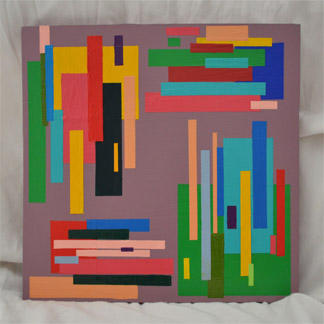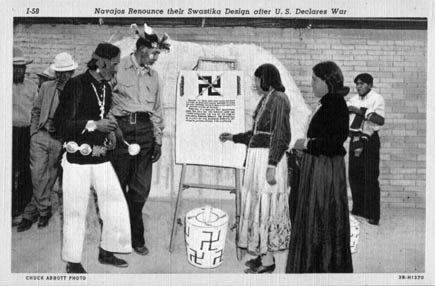
A Joyous Swastika
An Innocent Symbol
The
swastika is a joyous symbol, and in these works people know they are created
with no hatred in heart, as the ancient symbol of the swastika stands for many
things, to many cultures, all completely innocent.
I understand that it symbolizes horror to some, and plain negativity to others,
but I also understand enough to know those horrors were done under a banner
with a hakenkreuz (the symbol for Nazi Germany), and I vow never to play
with that specific symbol, and especially for what it stands in that sphere.
That aside, one cannot ask Buddhist, Vedic Indian (the word swastika
is Sanskrit), Chinese, or any other culture who currently use it, and have for
thousands of years, to stop its uses because a group of men, and their insane
ideas, defiled a short part of its long history. To that, we should never forget.
If a symbol is needed to define what that horror is, as the hakenkreuz,
I am fine with that, so long as they are fine with someone, like me, using the
swastika.
Numbers
1, 2, and 3 debuted at Superchief
Gallery's Incorrigible show (Manhattan, NY), March 2013
They were last shown in Santiago, Chile, at Kasa
Ecolety, January 2015
click
on images for larger view

Hindus have used
this sacred symbol in their Chakras for eons. Buddhists have been known to use
it, as well as calling it, "Buddha's heart", though they actually
use the swavastika (pointing to the left) more than the swastika (pointing to
the right). American Indians have used it for over 500 years, both to the left
and to the right.
The swastika means so many things; creative force, destruction, rebirth, divine
energy, the spirit or soul a.k.a. "fire inside", the four seasons,
etc. It has been used by the Greeks, Romans, Asians, Celts, Vikings, and Muslims.
Found throughout Europe, Asia, North America and the Middle East. The Hopis
used it to represent the migration of their four original tribes. The Norse
call it, The Hammer of Thor. It went by the name flyfoot and gammadion... and
honestly, the Germans never even called it the swastika. The German word for
it was, hakkenkreuz. Swastika is Sanskrit.
One of the best known articles on the swastika was written in 1894 and published
by the Smithsonian Institute, fifty years before the use we align it with today.
Actually, before the National Socialists, the swastika was everywhere to be
seen. Coca-Cola had a watch fob in the 1920s that said "Drink Coca-Cola--5¢
in bottles" with a big swastika in the middle. Pots and pan handles were
adorned with swastikas, as well as tin cans, mason jars, tea towels, hat-pins,
jewelry, tablecloths, you-name-it. All over the Art Deco district of Miami,
swastikas were seen on sides of buildings and even on the art deco clothing
of the early 30s... until, well you get the idea.
The Boy Scouts of America had pennies with swastikas. Even a badge of courage,
called The White Swastika. The Boy Scouts of Canada had a swastika badge as
well, you would receive it as a "thank you" if you were a nonmember
who did something good for the organization. Freemasons had swastika pennies
as well. The University of New Mexico yearbook was called The Swastika
until 1935 and a large swastika emblazoned on the cover. It was a symbol used
by lady's clubs all over America that were founded by The Ladies' Home Journal.
It appeared on the cover of the 1908 Sears Catalog. You can even find a mosaic
piece covered by swastikas at the University of Manitoba in Winnipeg and the
Furney Courthouse has swastika mosaics all over the damn place. Hell, them Canadians
loved the swastika so much they named a town after it! Swastika, Ontario. Their
baseball team had a large blue, what else... swastika on the front of their
uniforms.
In 1922 there were two all-female hockey teams named, The Swastikas. The Furney
Swastikas (which don't forget the courthouse mentioned earlier) who were the
1922 champions, and The Edmonton Alberta Swastikas.
As early as 1918, the Finnish air force had all planes adorned with large swastikas,
until 1944 when Russians kept shooting them down thinking they were the German
enemy.
In Germany it is illegal to even paint, draw or wear a swastika. So it just
goes to show you, the Jewish people are still sensitive about the swastika,
but the Aryans are almost as much. Guilt trip, I think?
The swastika is actually an innocent symbol. Innocent, by all accounts, of what
has been done in it's name. Museums and institutes, which usually rely on grants
both private and governmental, have rejected mostly anything that depicts the
swastika as anything other than a neo-Nazi symbol. When one steps into an area
that may offend, or sometimes even enlighten someone will always tell you to
step back because it must represent something that they believe must never be
forgotten.
And as always it takes a lone nut-job, like myself, to stand my ground and fight,
and maybe in the end open some eyes and start a new trend of awareness. Perhaps.
This is what ignorance does...

In the 1940s - to appease the U.S. government - Diné Americans (aka Navajo Indians) banned their own symbol.